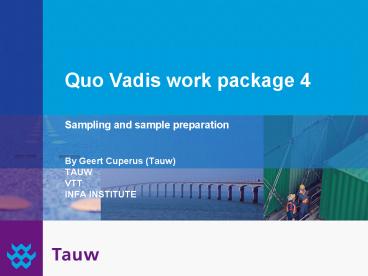Quo Vadis work package 4 - PowerPoint PPT Presentation
1 / 26
Title: Quo Vadis work package 4
1
Quo Vadis work package 4
- Sampling and sample preparation
- By Geert Cuperus (Tauw)
- TAUW
- VTT
- INFA INSTITUTE
2
Contents
- Background
- The new standard
- Validation of sampling and sample preparation
- Ruggedness testing
3
Background
- Inhomogenity is the issue
- Shape
- Variability in shape and size
- Occurance of substances
- Many elements occur concentrated in particles
- 99 of a substance in 1 of the SRF
- Subsamples keep containing such particles
4
Background
- Many types of SRF exist
- Fluff as complex example
- Sampling from static lots and stockpiles mostly
occur - Sampling consists of a series of steps
Sampling
Mass reduction
Size reduction
Analysis
Mass reduction
5
The new standard EN 15442
- Lot size (period of production)
- Number of increments
- Size of increments
- Distribution of increments
- Sample size
6
The new standard EN15442
7
The new standard EN 15442
- Minimum sample size
8
Validation of sampling
- Procedure
- Five production sites
- Samplers (5) apply EN15442 to draft a sampling
plan - Sampling (duplicate) of selected batches
- Evaluation of plans and sample performance by
Tauw - Analysis of elements by one laboratory
- Statistical analysis
9
Validation of sampling
10
Validation of sampling
- SAMPLE PREPARATION
- Samples to laboratory lt 5 kg.
- Particle size lt 30 mm.
- Sample preparation subsampling comminution
- WP4 investigated size reduction by
- Quartering
- Splitting
11
Validation of sampling
Sample preparation Quartering
12
Validation of sampling
Sample preparation Splitting
13
Validation of sampling
14
Validation of sampling
- Field experience
- EN15442 was easy to understand and practicable
- Some samplers indicated the standard is too
extensive - Useful comments resulted
- Proper sampling plans were drafted
15
Validation of sampling
16
Validation of sampling
Validation of sampling gt total standard
deviation Validation of sample preparation gt
minus sampling Therefore
17
Validation testing on sample preparationShare
sampling in total repeatability
18
Validation of sampling
- Results were used to adjust EN15442
- Practicable recommendations resulted
- Errors of repeatability frequently higher than
errors of reproducibility - Repeatability variation frequently negative or
gt100 - Other sources of error therefore have larger
influence
19
Ruggedness testing
- Several method parameters affect the reliability
of EN15442 - Of these, the lot size and the number of
increments are considered most important
20
Ruggedness testing on samplingStructure of the
investigation
- Preparation
- Research topics
- Parameters Cl, Hg, Cu, Cr
- Sampling focused on influence number of
increments (12, 24, 36, 48
and 60) - Sampling focused on influence lot size (500,
1500, 2500, 3500) - Field work at 4 sites (Italy, Norway, Germany,
Belgium) - Sample preparation analysis
- Calculation results and reporting
21
Ruggedness testing
Sampling at 4 sites
12 increments
24 increments
36 increments
48 increments
60 increments
5 samples A-E
5 samples A-E
5 samples A-E
5 samples A-E
5 samples A-E
22
Ruggedness testing
Sampling at 4 sites
500 ton
1.500 ton
2.500 ton
3.500 ton
5 samples A-E
5 samples A-E
5 samples A-E
5 samples A-E
23
Ruggedness testing on sampling Results
repeatability versus number of increments
24
Ruggedness testing on sampling Results
repeatability versus lot size
25
Ruggedness testing
- Optimum lot size is 2.500 ton (based on Cl, Hg
and Cr) - Optimum number of increments is 36
- However neither of these parameters dominate the
quality of a sample - Therefore 24 increments and lot size 1/10 of
annual production can well be applied
26
Conclusion
- Much work has been done now
- Go and try the standard for yourself!!
- THANK YOU































